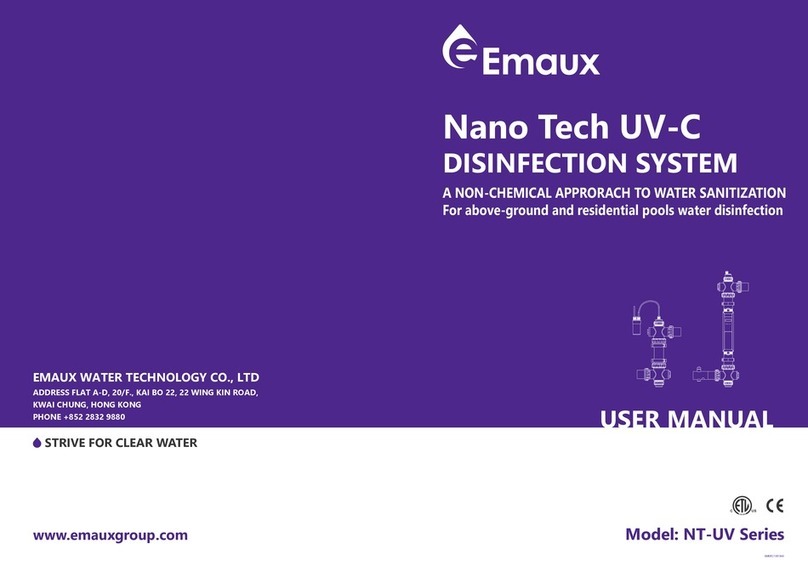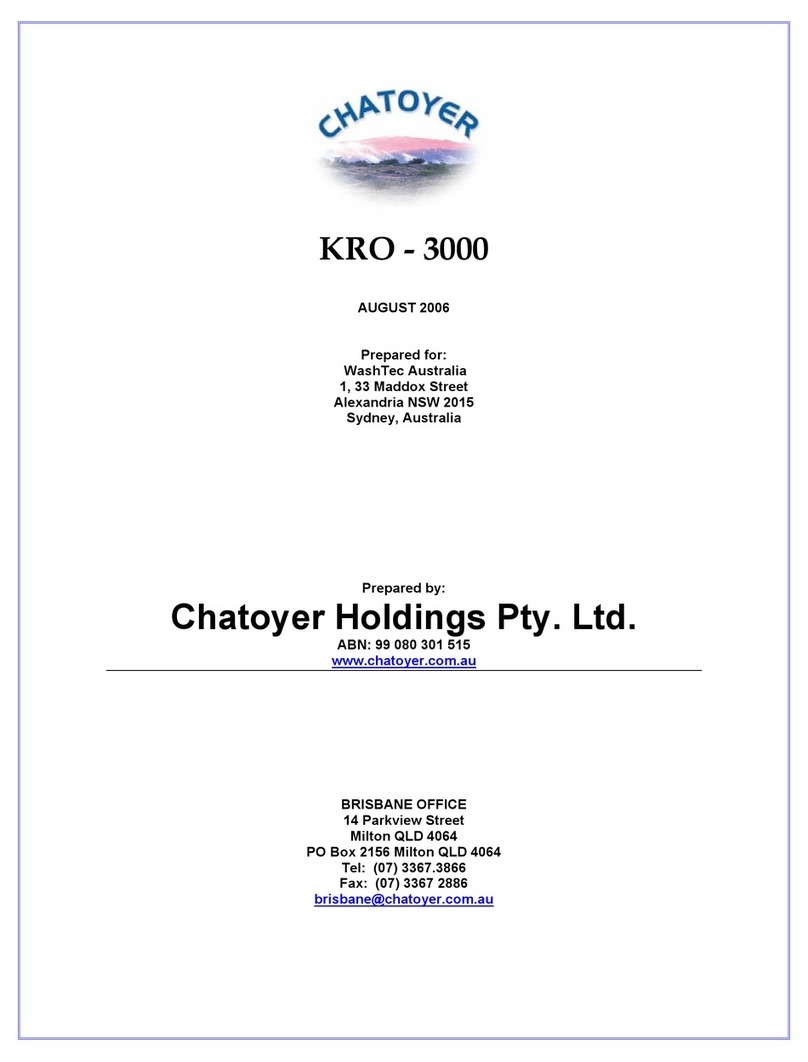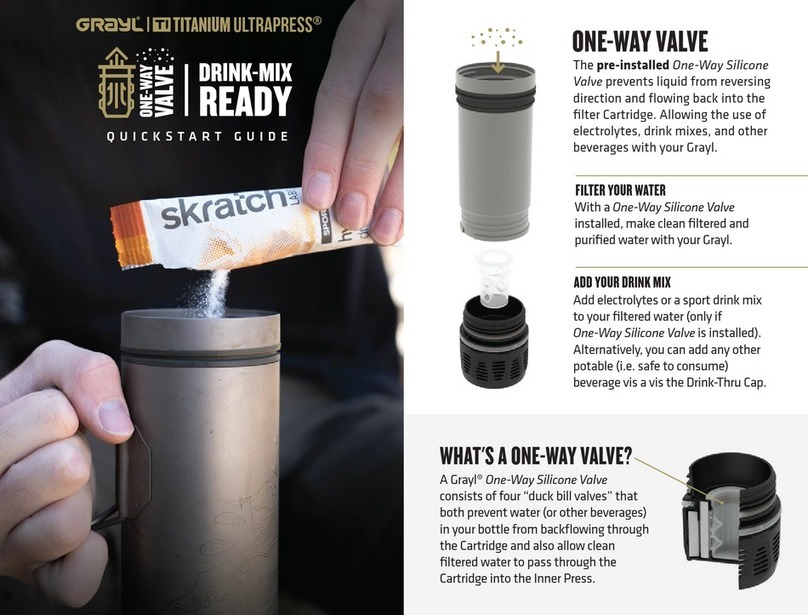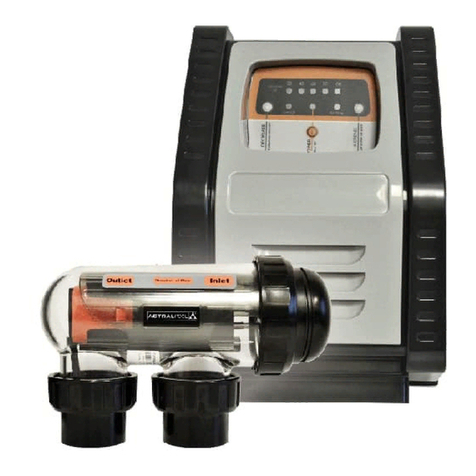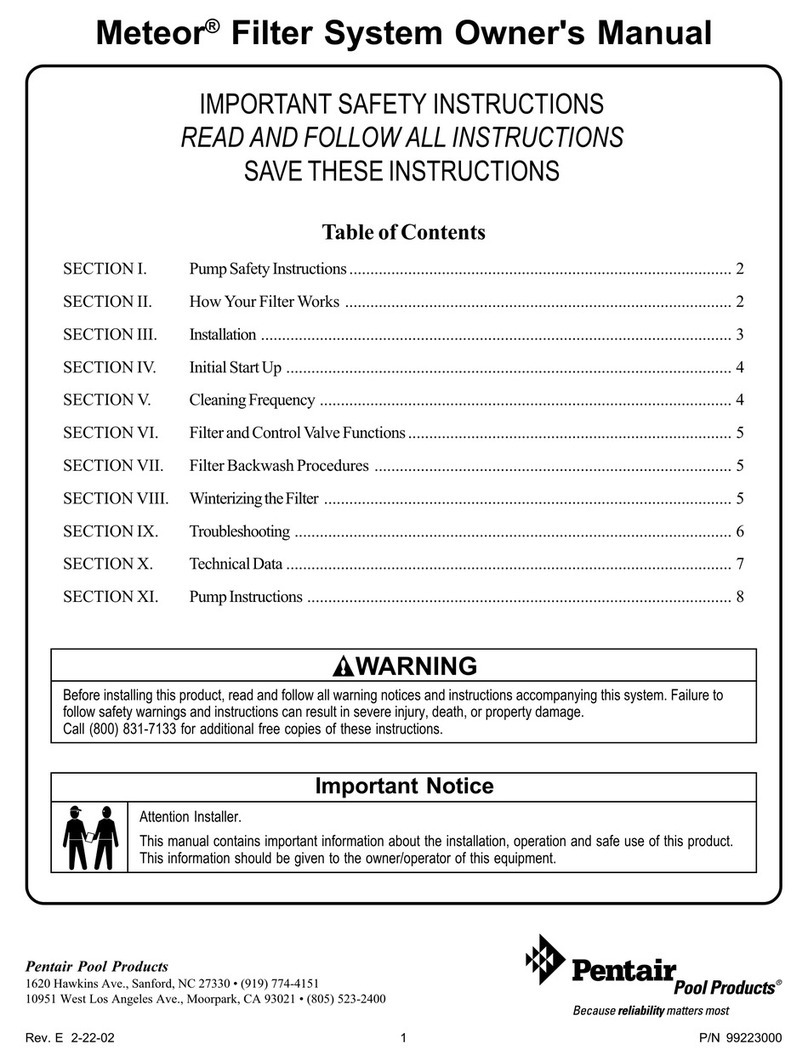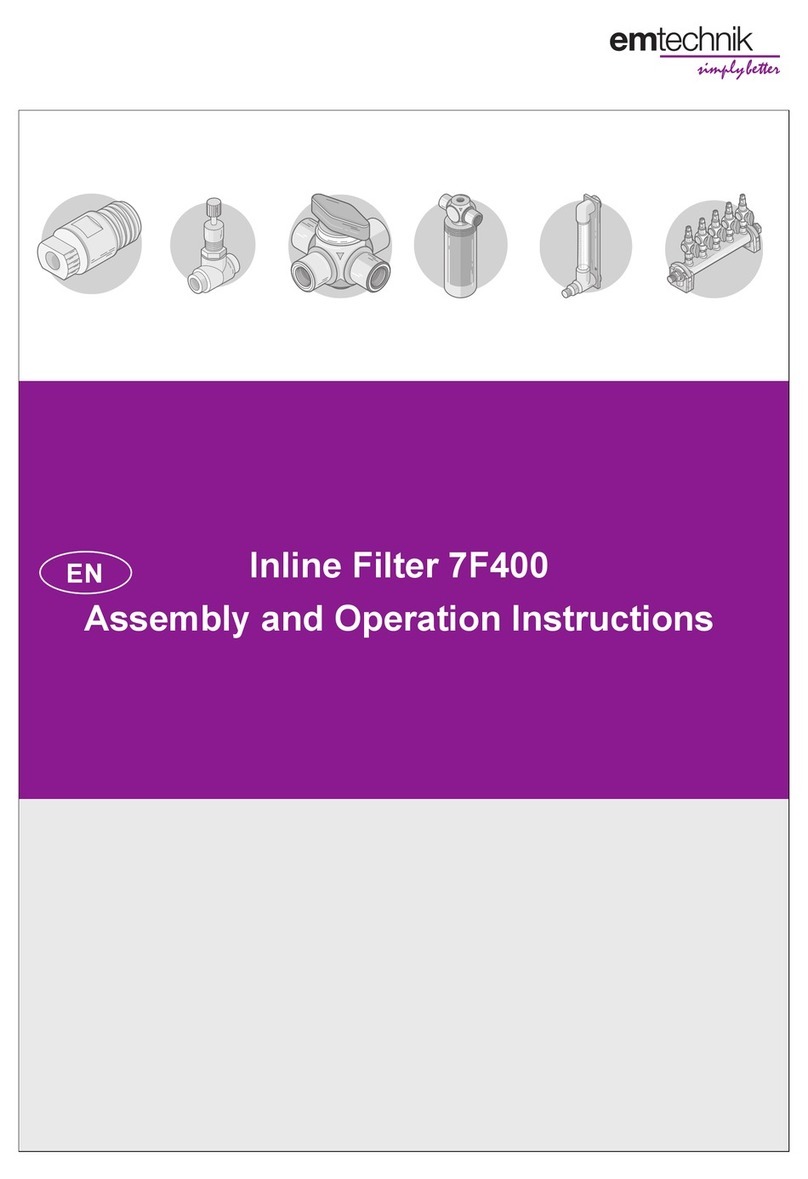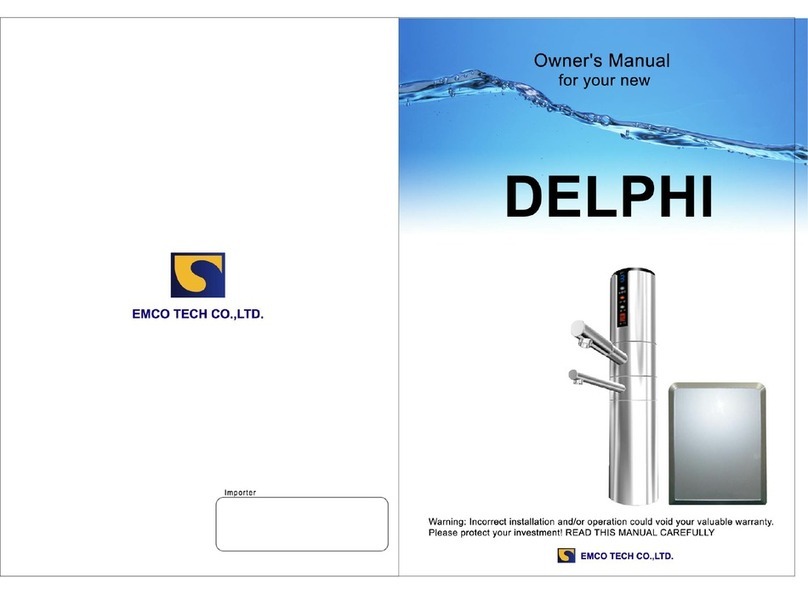CLASSICA K6842A User manual

O W N E R
'
S
M A N U A L
CLASSICA WATER SYSTEMS FILTRATION
Above
Counter
Model:
K6842A
Below
Counter
Model:
K6843B
This
system
has
been
tested
and
certified
by
WQA
against
NSF
/
ANSI
Standard
42
for
the
reduction
of
Particulates
-
Class
1,
Chlorine
Taste
and
Odor
reduction,
NSF
/
ANSI
Standard
53
for
the
reduction
of
Cyst,
Lead,
TIHMs
and
VOCs,
and
NSF
/
ANSI
Standard
372
for
low
lead
compliance.
System
Tested
and
Certified
by
NSF
lnternational
against
NSF
/
ANSI
Standard
42
for
the
reduction
of
Particulates.
Class
1,
Chlorine
Taste
and
Odor
reduction,
and
Standard
53
for
the
reduction
of
Cyst,
Lead,
TIHMs
and
VOCs.
L10193Wf 2021 Printed
in
USA

Congratulations!
You
have
made
a
wise
investment
in
good
living.
By
using
water
from
this
system
for
drinking
and
cooking,
you
will
taste
the
true
flavor
of
coffee,
tea,
and
juices.
NOTE:
Before
you
begin
unpacking
or
installing,
please
take
a
few
minutes
to
read
this
booklet
completely.
Table of Contents
Page
Important
Safety
Instructions
...........................................................................................................
1,2
Above
Counter
Installation
and
Start
Up
Procedure
...................................................................
3,4
Tools
Needed
for
Below
Counter
Installation
..................................................................................
5
Below
Counter
Installation
and
Start
Up
Procedure
....................................................................
5
-
8
Maintenance
...........................................................................................................................................
9
Filter
Cartridge
Replacement
.........................................................................................................
9
-
11
Troubleshooting
.............................................................................................................................
12,13
Warranty
................................................................................................................................................
14
2

Installation and Start Up Procedure
Screw
the
diverter
valve
(
A
)
onto
the
end
of
your
sink
faucet
and
tighten
by
hand
(
Fig.
1
)
.
The
diverter
valve
was
designed
tor
a
loose
fit.
Finger
tighten
only,
do
not
use
a
wrench
to
install
the
diverter
valve.
NOTE:
lf
the
diverter
valve
does
not
fit
on
your
faucet,
use
one
of
the
supplied
adapters
or
see
your
local
plumbing
distributor
or
supply
store
for
a
suitable
adapter
Turn
on
the
COLD
water
supply
and
turn
the
lever
up
on
the
diverter
valve
assembly
to
start
the
flow
of
the
water
into
the
system
(
Fig.
2
)
.
Turn
the
unit
upside
down
and
place
in
the
sink
on
a
padded
surface,
such
as
a
towel.
Press
and
hold
the
vent
valve
(
B
)
to
release
trapped
air.
Release
the
vent
valve
when
a
steady
stream
of
water
starts
to
flow
out
of
the
valve
(
no
air
bubbles
)
.
It
is
recommended
that
you
have
a
cloth
handy
to
wipe
up
any
water
that
splashes
out
of
the
vent
valve
(
Fig.
3
)
.
NOTE:
Air
will
not
pass
through
the
filler
cartridge.
Ali
air
trapped
in
the
system
must
be
released
through
the
vent
valve.
Press
the
system
faucet
lever
and
allow
water
to
pass
through
the
system
and
faucet
assembly
for
a
minimum
of
10
minutes.
Allow
a
few
minutes
for
water
to
flow
continuously
out
of
the
system
as
it
passes
through
the
filter
cartridge
before
timing
10
minutes
of
water
flow.
Examine
all
connections
for
leaks
while
the
water
is
flowing.
Carefully
tighten
or
secure
any
fittings
where
leaks
occur.
If
leaks
continue,
see
instructions
in
the
Troubleshooting
section
on
pages
12
and
13.
1.
2.
3.
4.
5.
ABOVE
COUNTER
SYSTEM
3

Place
the
system
into
the
faucet
holder.
Place
hoses
in
the
appropriate
slots
on
the
faucet
holder.
Position
the
faucet
holder
on
the
left
or
right
side
of
the
system
as
desired
(
Fig.
4
)
.
Slide
the
clamp
cover
over
the
stainless
steel
housing
and
snap
into
place
on
the
clamp
(
Fig.
5
)
.
To
shut
off
the
filler,
close
the
faucet
first,
then
turn
the
diverter
lever
downward.
A
small
amount
of
residual
water
may
continue
to
flow
from
the
diverter
valve
for
a
short
period
of
time
until
the
water
pressure
is
released
from
the
system.
(
Fig.
6
)
.
6.
7.
8.
4

Below counter Installation
Tools needed for installation:
You
will
need
a
razor
knife,
drill,
1
1
/
4
" (
31.8
mm
)
or
1
/
2
"' (
13
mm
)
drill,
slip
-
joint
pliers,
7
/
8
"
or
9
/
16
"
open
end
wrench,
adjustable
wrench,
and
the
Saddle
Valve
and
Faucet
Assembly.
CAUTION: Follow instructions exactly for connecting the hoses.
Reversing the hose connections will destroy the filler cartridge.
NOTE: Step 1 is required only if there is no existing hole in the
sink. It is recommended that only a professional drill a hole in a
porcelain sink.
Position
the
faucet
on
the
sink
ledge
or
counter
top
where
it
will
not
be
obstructed
above
or
below
the
sink
and
mark
the
location.
Drill
a
1.25
" (
31.8
mm
)
diameter
hole
in
the
marked
location
(
Fig.
7
)
.
Unscrew
the
brass
nut
from
the
threaded
end
of
the
faucet
body,
slide
down
the
tubing,
and
remove
the
slotted
washer.
Feed
all
three
tubes
through
the
1.25
" (
31.8
mm
)
hole
and
place
the
threaded
end
of
the
faucet
body
into
the
hole
(
Fig.
8
)
.
1.
2.
BELOW
COUNTER
SYSTEM
5

Replace
the
slotted
metal
washer
below
the
counter,
feed
all
three
tubes
through
the
brass
nut,
slide
up
the
tubing,
and
screw
onto
the
threaded
end
of
the
faucet
body
(
Fig.
9
)
.
NOTE:
You need two wrenches to tighten the faucet. Wrap a cloth
around the faucet to prevent scratches.
Insert
the
end
of
the
BLUE
tube
into
the
inlet
port
of
the
base
(
with
an
arrow
pointing
into
the
unit
)
.
Simply
push
the
tube
into
the
inlet
port
(
C,
Fig.
10
)
.
Insert
the
WHITE
tube
into
the
outlet
port
(
with
an
arrow
pointing
out
of
the
unit
) (
E,
Fig.
12
)
.
3.
4.
5.
NOTE:
To remove the tube, push in the collar (O) and pull out the tube
(Fig. 11).
6

In the Commonwealth of Massachusetts, plumbing code 248 CMR
shall be adhered to. Use of saddle valves Is not permitted. Please
consult with a licensed plumber for below counter installalions.
Remove
the
compression
hex
nut
(
F
)
with
ferrule
(
)
from
the
saddle
valve
(
H,
Fig.
13
)
.
1.
6.
IMPORTANT: Turn off the water supply!
To Connect to the Water Supply
Place
the
compression
hex
nut
with
ferrule
about
W
' (
13
mm
)
up
from
the
free
end
of
the
RED
inlet
tube.
(
Fig.
18
)
.
2.
lnstall
the
brass
tube
insert
(
1
)
into
the
end
of
the
red
tubing.
lnsert
the
tubing
into
the
threaded
end
of
the
saddle
valve
and
tighten
the
compression
nut
completely
(
Fig.
14
)
.
NOTE:
You need two wrenches to tighten the compression nut. Hold
the saddle valve from turning with one wrench while tightening the
compressíon nut.
3.
NOTE:
The saddle valve supplied is designed for installation on 3/8 to
5/8" (9.5 to 16 mm) diameter soft copper pipes. /f your cold water fine is
different, see your local plumbing distributor or plumbing supply store
for assistance.
Back
off,
or
unscrew,
the
wing
nut
to
ensure
that
the
piercing
needle
of
the
saddle
valve
is
retracted
(
Fig.
15
)
.
Attach
the
clamping
screw
and
the
saddle
valve
to
your
copper
cold
water
supply
pipe.
(
Do
not
over
tighten
clamping
screw
as
it
may
crimp
the
copper
pipe
thereby
restricting
the
flow
of
water
)
.
Use
the
smaller
end
for
the
3
/
8
" (
9.5
mm
)
copper
pipe
and
the
larger
end
for
the
7
/
16
to
5
/
8
" (
11
to
16
mm
)
diameter
pipe
(
Fig.
16
)
.
4.
5.
Turn
clockwise
and
advance
the
wing
nut
to
pierce
the
copper
pipe
using
a
pliers,
if
needed.
Turn
the
wing
nut
counter
clockwise
until
the
needle
valve
is
fully
retracted.
NOTE:
The
piercing
needle
must
be
retracted
for
water
to
flow
through
the
system.
Slide
the
clamp
cover
over
the
stainless
steel
housing
and
snap
into
place
at
the
base
(
Fig.
22
)
.
7.
8.
7

1.
6.
Star Up Procedure
2.
3.
NOTE:
Air will not pass through the filler cartridge. All air trapped in the
system must be released through the vent valve.
4.
5.
Press
the
system
faucet
lever
and
allow
water
to
pass
through
the
system
and
faucet
assembly
for
a
minimum
of
1
O
minutes.
Allow
a
few
minutes
for
water
to
flow
continuously
out
of
the
system
as
it
passes
through
the
filter
cartridge
before
timing
1
O
minutes
of
water
flow.
Examine
all
connections
for
leaks
while
the
water
is
flowing
and
with
the
water
turned
off.
Carefully
tighten
or
secure
any
fittings
where
leaks
occur.
If
leaks
continua,
see
instructions
in
the
Troubleshooting
m
section
on
pages
12
and
13.
To
obtain
filtered
water
for
cooking
and
drinking,
press
the
system
faucet
lever
(
Fig.
19
)
.
NOTE:
It is normal for vented faucets to drip a few drops of water after
the faucet lever is re/eased as the system is venting.
Set
the
unit
upside
down
on
a
cloth
inside
a
dish
pan
or
other
large
container.
Alter
checking
to
be
sure
that
the
piercing
needle
of
the
saddle
valve
is
fully
retracted,
turn
on
the
COLD
water
supply.
Press
and
hold
the
vent
valve
(
J
)
to
release
trapped
air.
Release
the
vent
valve
when
a
steady
stream
of
water
starts
to
flow
out
of
the
valve
(
no
air
bubbles
)
.
It
is
recommended
that
you
have
a
cloth
handy
to
wipe
up
any
water
that
splashes
out
of
the
vent
valve
(
Fig.
18
)
.
8

Only
minimal
maintenance
is
required
to
keep
your
system
working
effectively.
Regularly
clean
the
exterior
stainless
steel
surfaces
with
a
soft
sponge
and
warm,
soapy
water.
Use
a
mild,
non
-
abrasive
liquid
dish
washing
detergent.
Monthly
cleaning
of
the
diverter
valve
(
K
)
is
necessary
to
maintain
proper
valve
function.
To
clean,
remove
diverter
valve
from
faucet.
Soak
valve
in
a
solution
of
1
cup
water
and
1
/
4
vinegar
for
1
hour.
During
the
soaking
cycle,
activate
diverter
lever
(
L
)
every
15
minutes
(
Fig.
20
)
.
To
ensure
that
the
system
is
performing
effectively,
the
filler
cartridge
must
be
changed
every
1,000
gallons
(
3,785
liters
)
or
one
year,
dependent
on
conditions
of
use,
whichever
comes
first.
1.
3.
MAINTENANCE
Filter Cartridge Replacement
Please
read
the
following
instructions
completely
before
installing
or
replacing
your
cartridge.
CARTRIDGE REMOVAL
Disconnect
the
system
from
the
water
supply.
ABOVE COUNTER
-
Remove
the
diverter
valve
assembly
from
the
sink
faucet.
BELOW COUNTER
-
Turn
off
the
cold
water
supply
to
the
sink.
Invert
the
system
so
that
the
plastic
base
and
the
plumbing
connections
are
facing
up
and
the
top
of
the
stainless
steel
housing
is
resting
upside
down
on
a
clean
padded
surface,
such
as
a
towel.
Slide
the
plastic
clamp
cover
(
M
)
off
of
the
metal
housing
(
Fig.
21
)
.
Press
the
vent
valve
(
N
)
on
the
bottom
of
the
plastic
base
to
release
any
water
pressure
in
the
unit.
NOTE:
Do not proceed to Step 5 until the water pressure has been
released from the system (Fig. 21 ).
Open
the
clamp
and
release
the
safety
catch.
If
the
clamp
sticks,
simply
place
a
screwdriver
between
the
clamp
and
the
plastic
base
and
very
gently
twist
to
pry
apart
(
Fig.
22
)
.
Remove
the
clamp
from
the
system,
being
careful
not
to
scratch
the
stainless
steel
housing.
2.
5.
4.
9

DISINFECTION PROCEDURE
With
the
entire
system
placed
in
your
sink,
carefully
remove
the
stainless
steel
housing
from
the
plastic
base.
If
replacing
the
filter
cartridge,
remove
the
old
cartridge
from
the
base.
Place
in
a
plastic
bag
and
throw
away.
Scrub
the
inside
of
the
stainless
steel
housing
and
the
plastic
base
with
warm,
soapy
water
and
rinse
thoroughly.
Fill
the
stainless
steel
housing
half
way
with
tap
water.
Pour
1
to
2
ounces
of
liquid
household
bleach
into
the
water
that
is
in
the
stainless
steel
housing.
Re
-
attach
the
base
to
the
housing
and
re
-
lasten
the
clamp
to
assemble.
DO NOT INSTALL FIL TER CARTRIDGE AT THIS POINT
Connect
the
system
to
the
water
supply.
ABOVE COUNTER
-
Attach
the
diverter
valve
assembly
to
the
sink
faucet.
BELOW COUNTER
-
Turn
on
the
cold
water
supply.
Run
cold
tap
water
into
the
assembled
system
just
until
water
begins
to
flow
out
of
the
system
faucet.
Turn
off
the
water
and
allow
the
disinfecting
bleach
solution
to
stand
in
the
system
for
20
to
30
min.
Turn
on
the
water
and
run
tap
water
through
the
system
for
a
minimum
of
5
minutes,
or
until
the
odor
of
bleach
is
no
longer
present
in
the
water
flowing
from
the
system
faucet.
Repeat
steps
1
,
2,
and
5.
6.
7.
8.
9.
10.
11.
12.
13.
14.
16.
15.
CARTRIDGE INSTALLATION
Remove
the
plastic
base
from
the
stainless
steel
housing.
Place
the
base
on
a
clean
flat
surface
with
the
socket
of
the
base
(
to
hold
the
filler
cartridge
)
,
facing
upward.
After
removing
the
protective
plastic
bag
from
the
new
filter
cartridge,
wet
the
o
-
rings
on
the
filter
nipple
with
tap
water
to
lubricate.
Holding
the
filler
cartridge
upright,
insert
the
filler
cartridge
nipple
into
the
socket
in
the
base
by
pressing
straight
down
on
the
bottom
end
cap
of
the
filter
cartridge
(
Fig.
23
)
.
17.
19.
20.
18.
CAUTION: DO NOT wiggle, rock, or rotate the filler cartridge to insert it, simply press down. Make sure
that the o-rings have not rolled out of their grooves during insertion of the new cartridge nipple.
10

uide
the
base
and
the
filter
cartridge
into
the
stainless
steel
housing.
Replace
the
clamp,
positioning
the
latch
directly
under
the
inlet
portal
(
with
an
arrow
pointing
into
the
system
)
.
Check
to
be
sure
that
the
clamp
snaps
tightly
into
place
(
Fig.
24
)
.
SYSTEM INSTALLATION
In the Commonwealth of Massachusetts, plumbing code 248CMR
shall be adhered to. Use of saddle valves is not permitted. Please
consult with a licensed plumber for below counter installations.
22.
23.
24.
21.
25.
27.
26.
Connect
the
system
to
the
water
supply.
ABOVE COUNTER
-
Reinstall
the
diverter
valve
assembly
onto
your
sink
faucet,
turn
on
the
cold
water
valve
at
the
sink,
and
turn
the
lever
up
on
the
diverter
valve
to
start
the
flow
of
the
water
into
the
system.
BELOW COUNTER
-
Turn
on
the
cold
water
supply
and
open
the
water
faucet
to
flow
water
into
the
system.
Tilt
the
system
so
that
the
vent
valve
is
elevated.
Depress
the
vent
valve
to
release
trapped
air.
NOTE: Air will not pass through the filter cartridge. Al/ air trapped in the system must be released
through the vent valve.
Release
the
vent
valve
when
a
steady
stream
of
water
begins
to
flow
out
of
the
valve
(
no
air
bubbles
)
.
It
is
recommended
that
you
have
a
cloth
handy
to
wipe
up
any
water
that
splashes
out
of
the
vent
valve.
Allow
water
to
pass
through
the
system
and
the
faucet
assembly
for
a
minimum
of
10
minutes.
Allow
a
few
minutes
for
water
to
flow
continuously
out
of
the
system
as
it
passes
through
the
filter
cartridge
before
timing
10
minutes
of
water
flow.
Examine
all
connections
for
leaks
with
the
water
flowing
and
with
the
water
turned
off.
Carefully
tighten
or
secure
any
fittings
where
leaks
occur.
lf
leaks
continue,
see
instructions
in
the
Troubleshooting
section
on
pages
12
and
13.
Resume
normal
use.
Record
the
date
of
the
filler
cartridge
installation
and
mark
your
calendar
to
repeat
this
procedure
on,
or
before,
the
recommended
service
period.
28.
29.
30.
11

PROBLEM:
The
flow
rate
decreases
even
when
the
water
valve
is
fully
opened.
The
filter
cartridge
should
provide
1,000
gallons
(
3,785
liters
)
of
filtered
water,
enough
to
supply
a
family
of
four
with
drinking
and
cooking
water
for
a
year.
However,
filter
cartridge
replacement
depends
on
the
amount
of
water
consumed
in
your
household
and
on
the
quality
of
your
water
supply.
When
the
filter
cartridge
is
nearing
the
end
of
its
lite
expectancy,
you
may
notice
a
drop
in
the
flow
rate
even
with
the
water
valve
fully
open.
Usually
the
slow
flow
rate
will
indicate
that
it
is
time
to
replace
the
cartridge.
Naturally
occurring
carbon
dioxide
or
air
leaking
into
the
water
supply.
(
In
rare
cases,
the
gas
is
naturally
occurring
hydrogen
sulfide,
indicated
by
a
rotten
egg
odor.
)
as
or
air
bubbles
will
not
pass
through
the
filler
cartridge.
Bleed
the
gas
or
air
from
the
system
by
depressing
the
vent
screw
located
on
the
underside
of
the
base.
Have
a
towel
handy
to
absorb
any
water
that
might
splash
out
of
this
vent
screw
opening.
When
the
flow
rate
is
restored,
you
will
need
to
periodically
bleed
the
gas
or
air
from
the
system
to
maintain
the
proper
flow
rate.
High
level
of
dirt
or
other
particulates
in
the
water
supply.
Fill
a
clear
glass
with
unfiltered
water
and
allow
to
stand.
If
alter
10
minutes
the
water
remains
cloudy,
there
is
a
high
level
of
dirt
in
the
water.
This
may
be
a
permanent
condition
or
a
temporary
problem
caused
by
heavy
rains,
repairs
to
water
mainlines,
or
the
cleaning
of
municipal
water
mains,
etc.
You
may
have
to
replace
the
filler
cartridge.
TROUBLESHOOTIN
SOLUTION:
Cold
water
does
not
flow
out
of
the
filtration
system.
There
is
an
air
bubble
build
-
up
in
the
system
housing.
Air
will
not
pass
through
the
filter
cartridge.
Bleed
the
trapped
air
from
the
system
by
depressing
the
vent
valve
on
the
base
of
the
system
(
see
step
3
on
page
3
or
step
3
on
page
8
of
the
Start
Up
(
Instructions
)
.
The
saddle
valve
piercing
needle
has
not
pierced
the
cold
water
fine
or
the
wing
nut
has
not
been
fully
backed
off
to
retract
the
piercing
needle
and
open
the
saddle
valve.
Ensure
that
the
copper
pipe
has
been
pierced
and
that
the
wing
nut
is
backed
off
completely
to
retract
the
piercing
needle
and
open
the
saddle
valve
(
see
steps
6
and
7
on
page
7,
To
Connect
to
the
Water
Supply
)
.
......................................................................................................................................................................
.
CAUSE:
CAUSE:
SOLUTION:
CAUSE:
SOLUTION:
PROBLEM:
CAUSE:
SOLUTION:
CAUSE
:
SOLUTION:
12

PROBLEM:
Water
leaks
from
the
fittings.
Loose
connections
at
the
fittings.
Fully
insert
tubing
into
the
fittings
where
leaks
occur.
If
leaks
persist,
disassemble
the
system
and
make
sure
that
all
of
the
o
-
rings
and
seals
are
in
place.
SOLUTION:
Bad
smelling
water
(
rotten
egg
odor
)
.
Bacteria
build
-
up
inside
the
filler
or
hydrogen
sulfide
in
the
water
supply.
Disinfect
the
complete
system
and
change
the
cartridge
(
see
Filler
Cartridge
Replacement,
pages
9
-
11
)
.
......................................................................................................................................................................
CAUSE:
CAUSE:
SOLUTION:
SOLUTION:
PROBLEM:
CAUSE:
SOLUTION:
CAUSE
:
......................................................................................................................................................................
PROBLEM:
Filtered
water
has
a
"
milky
white
"
or
cloudy
appearance.
Use
of
hot
water
in
the
system.
Stop
using
hot
water
immediately
and
Flush
the
system
with
several
gallons
of
cold
water.
The
system
is
passing
air.
Vent
the
system
as
indicated
to
release
trapped
air
(
see
step
3
on
page
3
or
step
3
on
page
8,
Start
Up
instructions
)
.
If
problem
still
persists:
Check
to
make
sure
that
the
cartridge
is
properly
sealed
in
the
manifold
base.
Make
sure
that
either
of
the
two
o
-
rings
have
not
rolled
out
of
their
grooved
positions.
1.
2.
......................................................................................................................................................................
13

CLASSICA
WATER
SYSTEMS
warrants
that
the
stainless
steel
canister
and
base
clamp
will
be
free
from
defects
in
materials
and
workmanship
for
the
lifetime
of
the
product
and
that
the
plastic
base.
clamp
cover,
and
manifold
will
be
free
from
defects
in
materials
and
workmanship
for
five
years.
Further,
that
all
other
parts
of
the
system
(
excluding
the
filter
cartridge
)
furnished
by
CLASSICA
WATER
SYSTEMS
will
be
free
from
defects
in
materials
and
workmanship
for
one
year
from
the
date
of
purchase.
This
warranty
is
valid
provided
that
the
system
is
used
and
cared
for
in
accordance
with
the
Classica
Water
Systems
owner
'
s
manual
and
only
CLASSICA
WATER
SYSTEMS
authorized
replacement
cartridges
are
used.
This
warranty
is
extended
to
the
original
purchaser
only.
In
order
to
be
entitled
to
warranty
service,
complete
and
return
the
owner
'
s
registration
card
immediately
at
the
time
of
purchase.
Also,
by
completing
and
mailing
in
the
owner
'
s
registration
card,
you
will
be
reminded
when
it
is
time
to
replace
the
filter
cartridge.
The
Classica
Water
Systems
filler
cartridge
is
designed
to
be
a
highly
effective
filter.
The
carbon
block
filter
should
be
replaced
at
least
once
a
year.
if
you
live
in
an
area
where
the
quality
of
the
water
is
very
turbid,
you
may
notice
a
gradual
reduction
of
the
water
flow
coming
from
the
system
'
s
spout.
Under
these
conditions,
when
the
flow
becomes
undesirable,
you
may
need
to
replace
the
filler
cartridge
more
frequently
than
once
a
year.
For
service
under
this
warranty,
please
contact
the
water
filter
distributor
who
sold
you
the
product.
You
will
be
instructed
how
to
resolve
the
problem.
If
a
part
or
the
entire
system
is
to
be
returned
to
the
distributor,
sufficiently
pack
it,
include
postage
and
insurance
prepaid,
and
a
note
with
a
brief
description
of
the
product
detect,
the
date
that
you
purchased
the
product,
and
the
serial
number
found
on
the
bottom
of
the
product.
Any
parts,
which
upon
examination
by
CLASSICA
WATER
SYSTEMS,
are
found
to
be
detective
will
be
repaired
or
replaced
free
of
charge
during
the
warranty
period.
This
warranty
does
not
apply
to
damage
resulting
from
accident,
modification,
tampering,
misuse
or
premature
clogging,
nor
does
it
cover
damage
resulting
from
service
by
persons
other
than
CLASSICA
WATER
SYSTEMS
authorized
service
personnel.
CLASSICA
WATER
SYSTEMS
'
LIABILITY
UNDER
THIS
WARRANTY
IS
LIMITED
TO
THE
REPAIR
OR
REPLACEMENT
OF
A
DEFECTIVE
PRODUCT
OR
COMPONENT
AT
CLASSICA
WATER
SYSTEMS
'
SOLE
OPTION.
CLASSICA
WATER
SYSTEMS
SHALL
NOT
BE
LIABLE
FOR
ANY
PERSONAL
INJURY,
PROPERTY
DAMA E,
OR
ANY
INCIDENTAL
OR
CONSEQUENTIAL
DAMA ES,
WHETHER
DIRECT
OR
INDIRECT,
OF
ANY
KIND
RESULTIN
FROM
A
DEFECT
IN
OR
MALFUNCTION
OF
THIS
WATER
FILTER
SYSTEM.
THIS
WARRANTY
IS
EXPRESSLY
RANTED
IN
LIEU
OF
ALL
OTHER
WARRANTIES,
INCLUDIN
THE
IMPLIED
WARRANTIES
OF
MERCHANTABILITY
AND
FITNESS
FOR
A
PARTICULAR
PURPOSE.
CLASSICA
WATER
SYSTEMS
LIMITED
WARRANTY
14
This manual suits for next models
1
Table of contents
Popular Water Filtration System manuals by other brands

Schenker
Schenker SMART 80 Installation, use and maintenance manual
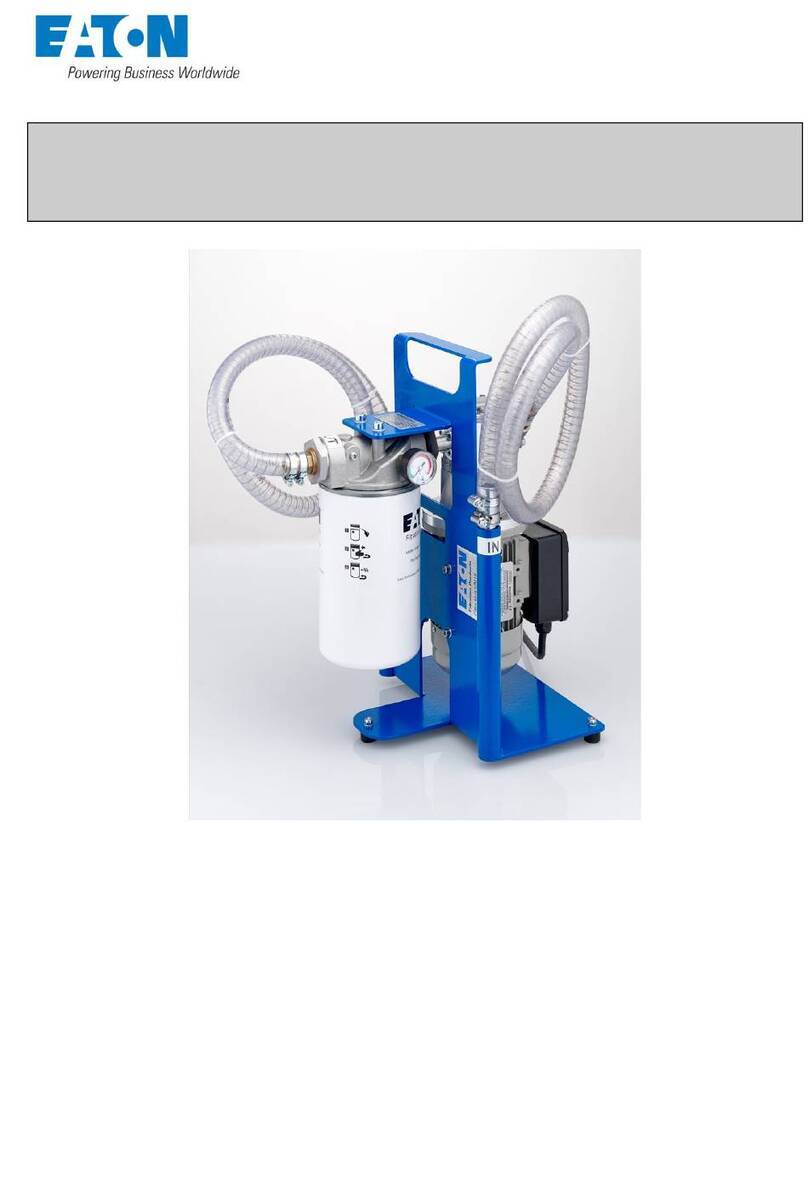
Eaton
Eaton UM15 operating instructions
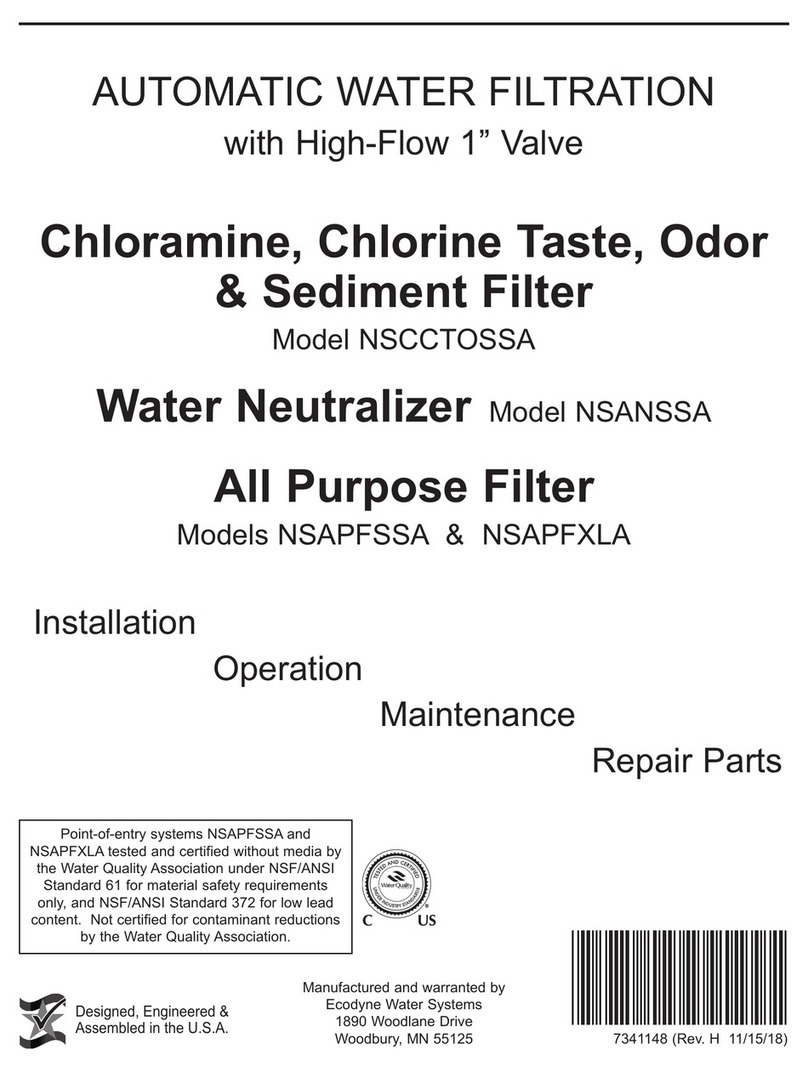
Ecodyne Water Systems
Ecodyne Water Systems HPF Installation, operation, maintenance & repair parts
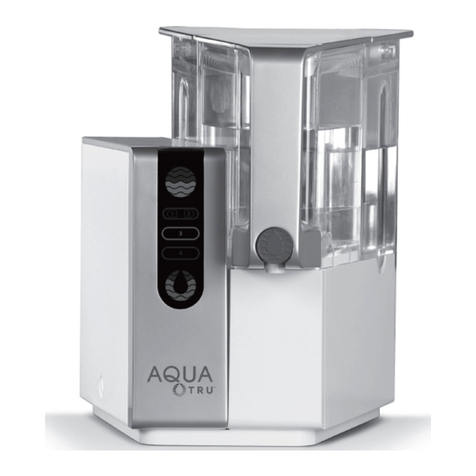
AquaTru LLC
AquaTru LLC AquaTru owner's manual

Hague Quality Water
Hague Quality Water HW-RO-B Owner's manual & installation guide
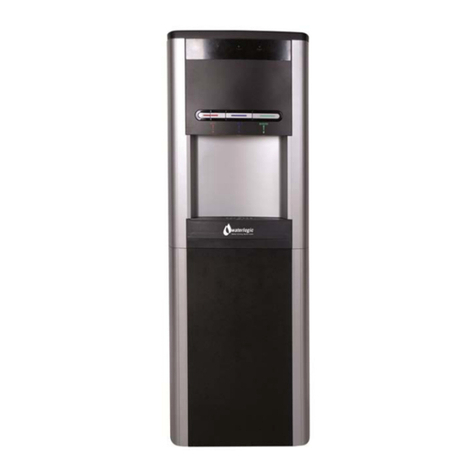
WaterLogic
WaterLogic WL270 Service manual



